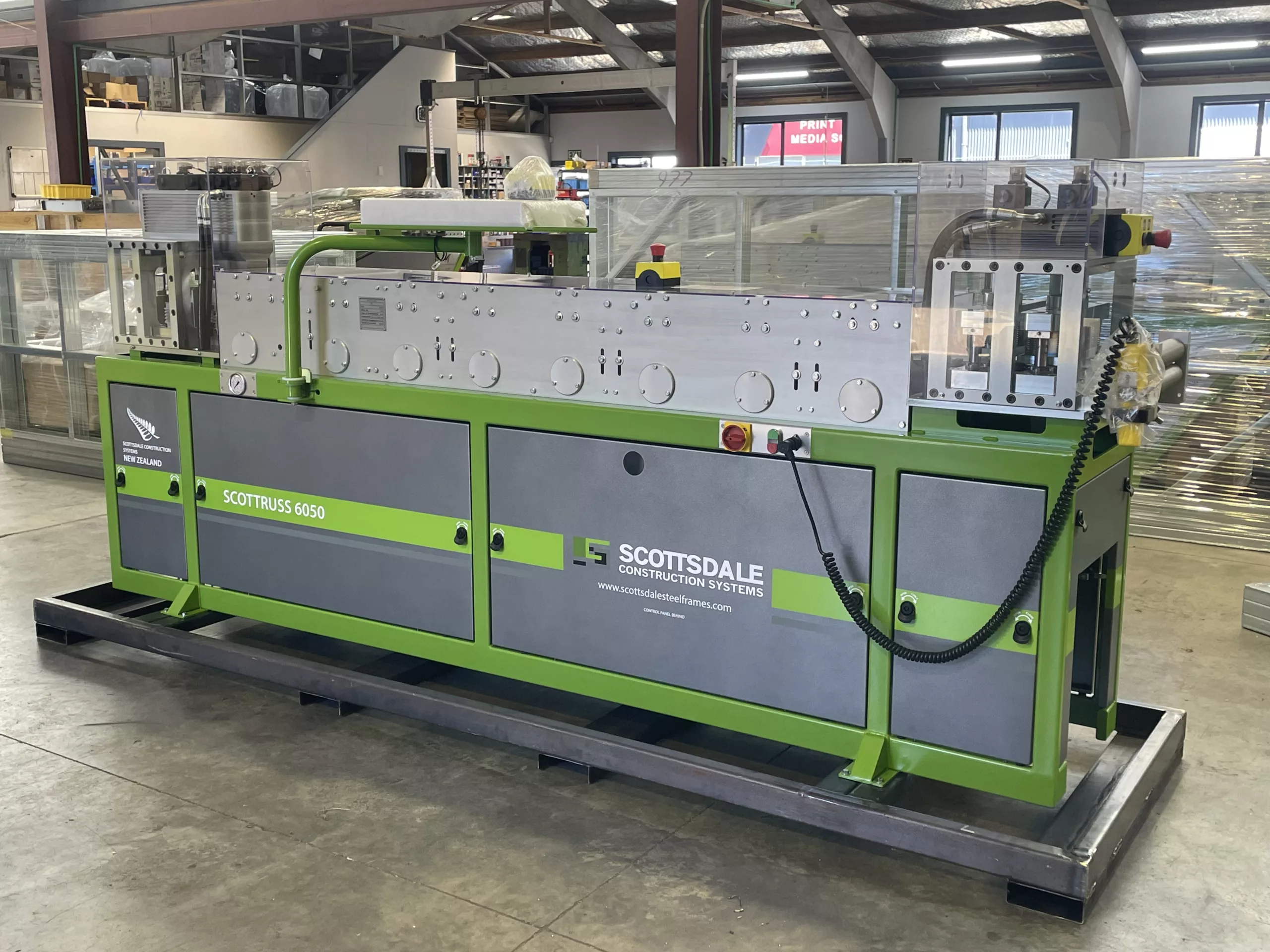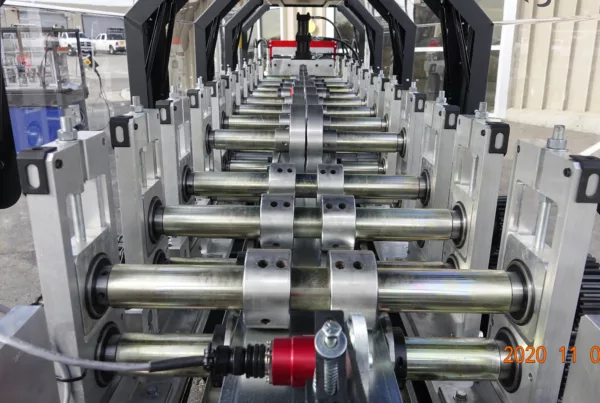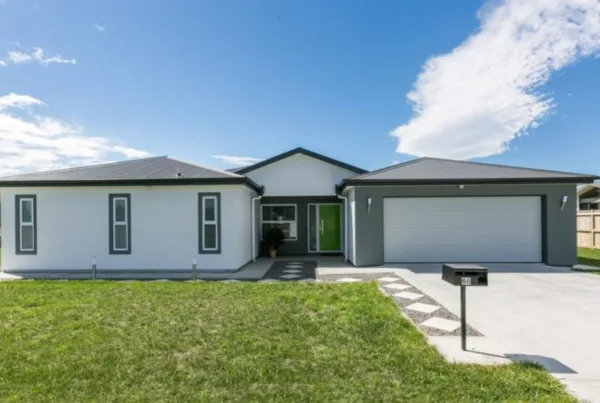If you’re in the construction industry, especially in steel framing, investing in a roll forming machine can be a game-changer. Whether you’re building with light-gauge steel on-site or prefabricating components off-site, roll forming offers speed, precision, and cost-efficiency.
In this guide, we’ll explore the top benefits of using a roll former machine and why more builders are adopting this technology. From lower construction costs to sustainable steel framing, here are the seven biggest roll forming benefits to know.
How Does a Roll Forming Machine Work?
Roll forming machines produce such studs and tracks with speed and precision, enabling efficient on-site or off-site steel framing.
A roll forming machine works by gradually shaping a flat coil of steel into a finished profile, such as a stud, track, or channel, through a series of precisely positioned rollers.
As the steel moves through the machine, each roller station bends the material slightly more until it reaches its final form. Unlike traditional stamping or press braking, roll forming is continuous, fast, and ideal for high-volume production. Modern roll formers are often integrated with CAD software, allowing contractors to design and produce light-gauge steel framing components with pinpoint accuracy, including pre-punched holes for utilities.
Whether operated on-site or in a factory, roll forming machines deliver consistent, ready-to-install components with minimal waste and manual labor.
Modern roll forming machines have transformed how construction businesses fabricate light-gauge steel framing components like studs and tracks.
What Are The Benefits of Using a Roll Forming Machine?
Roll forming machines offer numerous benefits for steel framing contractors. These machines are engineered to deliver high precision, efficiency, and consistency in the production of light gauge steel components. By automating key aspects of the framing process, roll forming technology helps streamline operations, reduce waste, and improve overall build quality.
Below are seven core advantages of utilizing roll forming technology in a steel framing operation, focusing on speed, cost, quality, flexibility, sustainability, fire safety, and more.
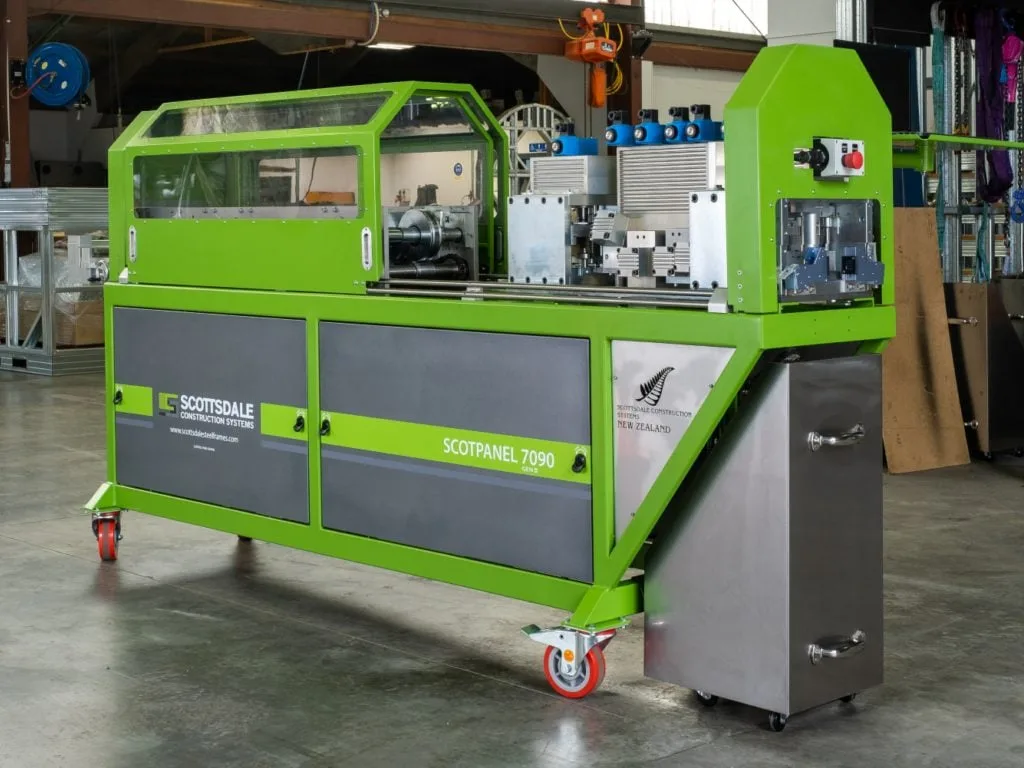
1. Faster Construction and Higher Productivity
One major advantage of roll forming machines is the speed at which they can produce framing components, which translates into faster construction timelines.
Light-gauge steel framing can be fabricated 50% faster or more compared to traditional methods. Because components can be manufactured ahead of time (often off-site) or on-demand on-site, there is far less work needed in the field. No cutting or drilling holes on-site is required, since parts arrive ready to assemble like a kit.
This dramatically reduces installation time and labor. Overall, faster fabrication and quick assembly mean construction projects can be completed much sooner, improving productivity and allowing a business to take on more projects.
2. Cost Savings and Efficiency
Investing in a roll former can lead to significant cost savings for a steel framing business. Automation reduces labor requirements.
Faster builds also cut labor hours on-site, directly saving money. Additionally, roll forming optimizes material usage; it generates minimal waste (scrap rates as low as 1–2%) compared to traditional cutting methods. This material efficiency lowers the cost per project, since material wastage is up to 10× lower than with timber framing.
Businesses also save on shipping and procurement: producing studs and tracks in-house (or on-site) means fewer transportation costs and no markup from third-party suppliers. Steel coils are relatively easy to transport, and the finished frames are lightweight, further reducing handling and freight expenses.
All these factors, reduced labor, less waste, and lower logistics costs, make roll forming a highly efficient, cost-effective choice for steel framing.
3. Precision and Consistent Quality
Roll forming machines deliver a level of precision and consistency that is hard to match with manual fabrication.
These machines are CNC-controlled and often integrated with CAD/BIM design software, so your digital designs feed directly into production.
The result is components formed to exact specifications every time. Light-gauge steel studs can be produced accurate to within 0.5 mm when using modern roll-forming technology. Such accuracy means holes for utilities are pre-punched in exactly the right locations and every stud or track fits perfectly, eliminating on-site adjustments. Because cutting is done by the machine, field cutting is essentially eliminate – crews aren’t sawing or trimming materials to make them fit.
This not only speeds up assembly but also improves quality: there’s far less rework or error, and the uniformly fabricated pieces result in straighter walls and a high-quality finish. The consistency of factory-formed steel framing also reduces issues like material warping or variability that are common with wood. In short, roll forming ensures precision-engineered components that enhance overall build quality and reduce costly mistakes
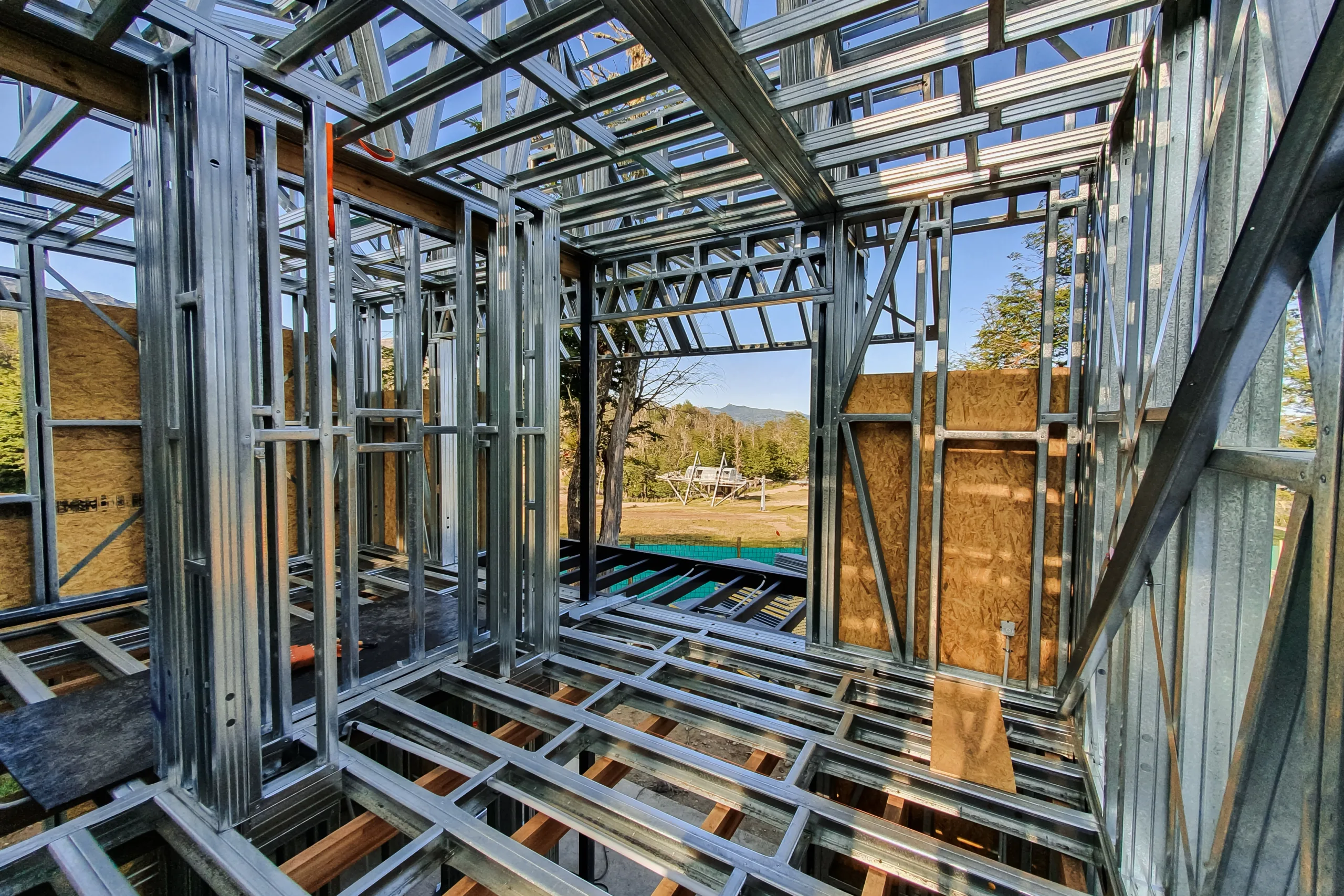
4. Design Flexibility and Supply Independence
Using your own roll forming machine gives a steel framing operation tremendous flexibility and independence in both design and supply.
You are no longer limited to the standard profiles or lengths offered by suppliers. The machine can be configured to create custom stud and track shapes to suit specialized design needs.
Likewise, you can produce framing members in any length, from very short pieces to extra-long studs, with precise cuts, which might not be available off-the-shelf. This flexibility is especially useful for complex projects or optimized designs that seek to minimize joints and waste.
Supply-chain delays and inventory shortages also become less of a concern. With in-house roll forming, you’re not dependent on a stud manufacturer’s lead times or stock availability, which during supply crises can be weeks or months. Instead, you can manufacture exactly what you need when you need it.
This on-demand production means faster project turnaround and the ability to adapt if design changes occur late in the process. In essence, owning a roll forming machine turns a contractor into their own supplier, providing control over production and the agility to meet project requirements without waiting on external deliveries.
5. On-Site and Off-Site Versatility
Roll forming machines support both off-site prefabrication and on-site fabrication, giving construction teams versatile options to improve efficiency.
In an off-site scenario (factory or workshop), you can fabricate wall panels, roof trusses, and other assemblies in a controlled environment. This maximizes productivity and quality, and it minimizes on-site work – panels arrive ready to install, greatly expediting project completion.
Off-site manufacturing also reduces errors and weather delays: components are made with automation (so mistakes are caught early), and construction isn’t slowed by rain or climate since much of it is done under roof.
On the other hand, on-site roll forming is extremely useful for remote or dispersed project locations.
Instead of shipping bulky pre-made frames over long distances, a mobile roll former can be brought to the job site to produce components on location. This is ideal when the site is far from any industrial center: you simply transport coils of steel and form the studs/tracks as needed on-site.
On-site fabrication cuts down on transport costs and allows immediate adjustments if any piece needs to be modified during construction.
In summary, having roll forming capability means you can choose the most efficient construction method (prefab vs. on-site fabrication) case by case. Off-site production offers peak efficiency and quality control, while on-site production offers logistical convenience and responsiveness in the field.
6. Sustainability and Waste Reduction
Cold formed steel framing with roll forming aligns well with modern sustainability goals. Material waste is minimized thanks to precise fabrication, roll forming can utilize over 98% of the steel coil, producing as little as 2% scrap (versus up to 20% waste in some traditional cuts).
This not only saves money but also reduces the amount of construction debris heading to landfills. Any scrap that is produced is just steel off-cuts, which are 100% recyclable. In fact, steel is one of the most recyclable materials in construction; light-gauge steel framing is often cited as being 99% recyclable overall. Using steel studs in place of wood also spares forests and reduces the environmental impact associated with lumber.
Steel framing can contribute to greener buildings in other ways too.
The high precision of roll-forming enables very tight tolerances, which makes it easier to create well-sealed, energy-efficient building envelopes (reducing heating/cooling losses). Steel’s strength-to-weight ratio means structures can be lighter, potentially requiring less material in foundations and other elements.
Additionally, steel components don’t emit VOCs or support mold growth, improving indoor air quality. From a sustainability perspective, roll-formed steel framing yields efficient use of resources, recyclable components, and often better energy performance of the finished building. All of this helps construction firms meet green building standards and appeal to environmentally conscious clients.
7. Fire Resistance and Structural Durability
Light-gauge steel framing produced by roll forming is also prized for its fire resistance and durability.
Unlike wood, steel is a non-combustible material; it will not ignite or contribute fuel to a fire. This greatly reduces the risk of structural fires. Electrical sparks or wildfires that would normally ignite wood framing cannot ignite steel studs, and fire will not spread within steel wall cavities the way it can in wood-framed walls.
Many building codes recognize these safety advantages, and steel framing can lead to improved fire ratings for walls and lower insurance premiums. Proper fire-resistant cladding or coatings are still used, since extreme heat can weaken steel, but the key is that steel won’t burn or produce smoke.
Steel framing is also highly resilient and long-lasting.
Roll-formed components are galvanized to resist corrosion, and they do not warp, rot, or shrink over time like wood does. This means structures remain straight and true for decades with minimal maintenance.
Steel is impervious to termites and other pests that can destroy wood framing, ensuring the structural integrity isn’t silently eaten away. Additionally, steel’s durability in harsh weather (no mold or moisture damage, and it maintains strength in high winds if properly engineered) gives buildings a longer lifespan.
For the construction business, this durability means fewer warranty issues and call-backs due to framing problems, and a better reputation for delivering quality structures.
Examples of Roll Forming Machines
Scottsdale Construction Systems provides a powerful lineup of roll forming machines designed specifically for light‑gauge steel framing.
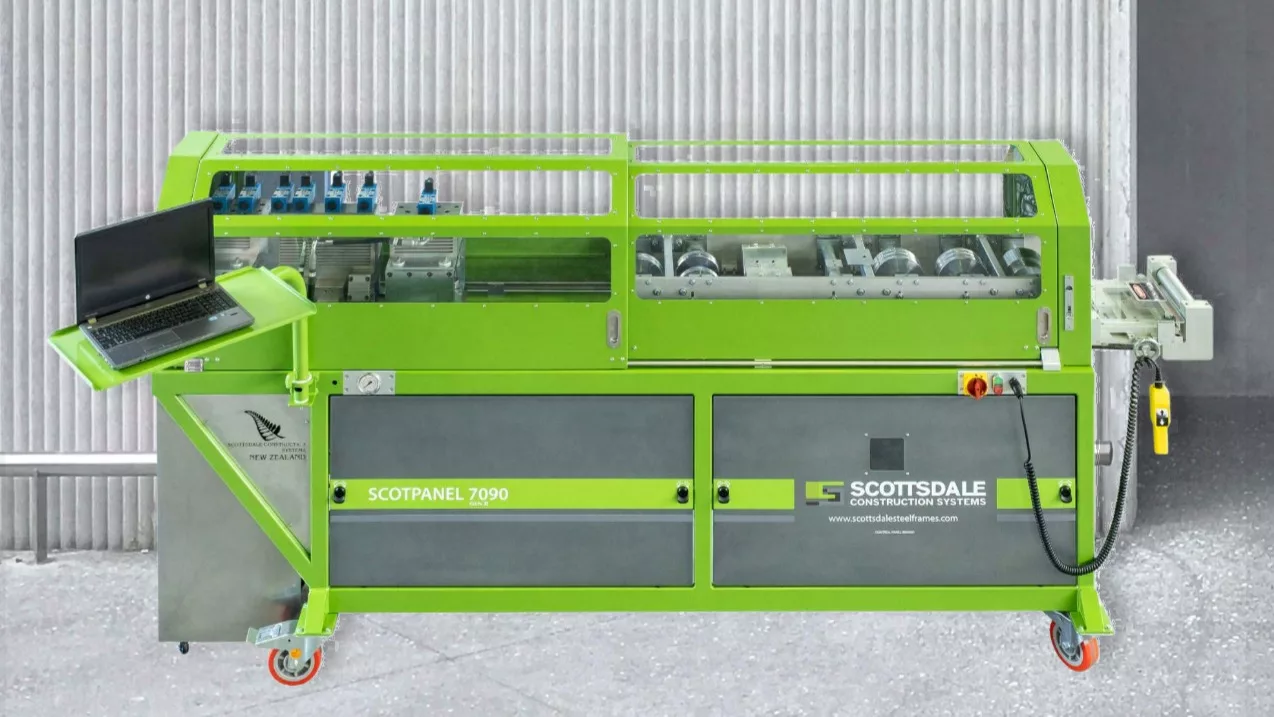
SCOTPANEL
A versatile roll former designed to produce Cee section profiles for use in walls, roofs, ceilings, and support frames in low to mid-rise construction.
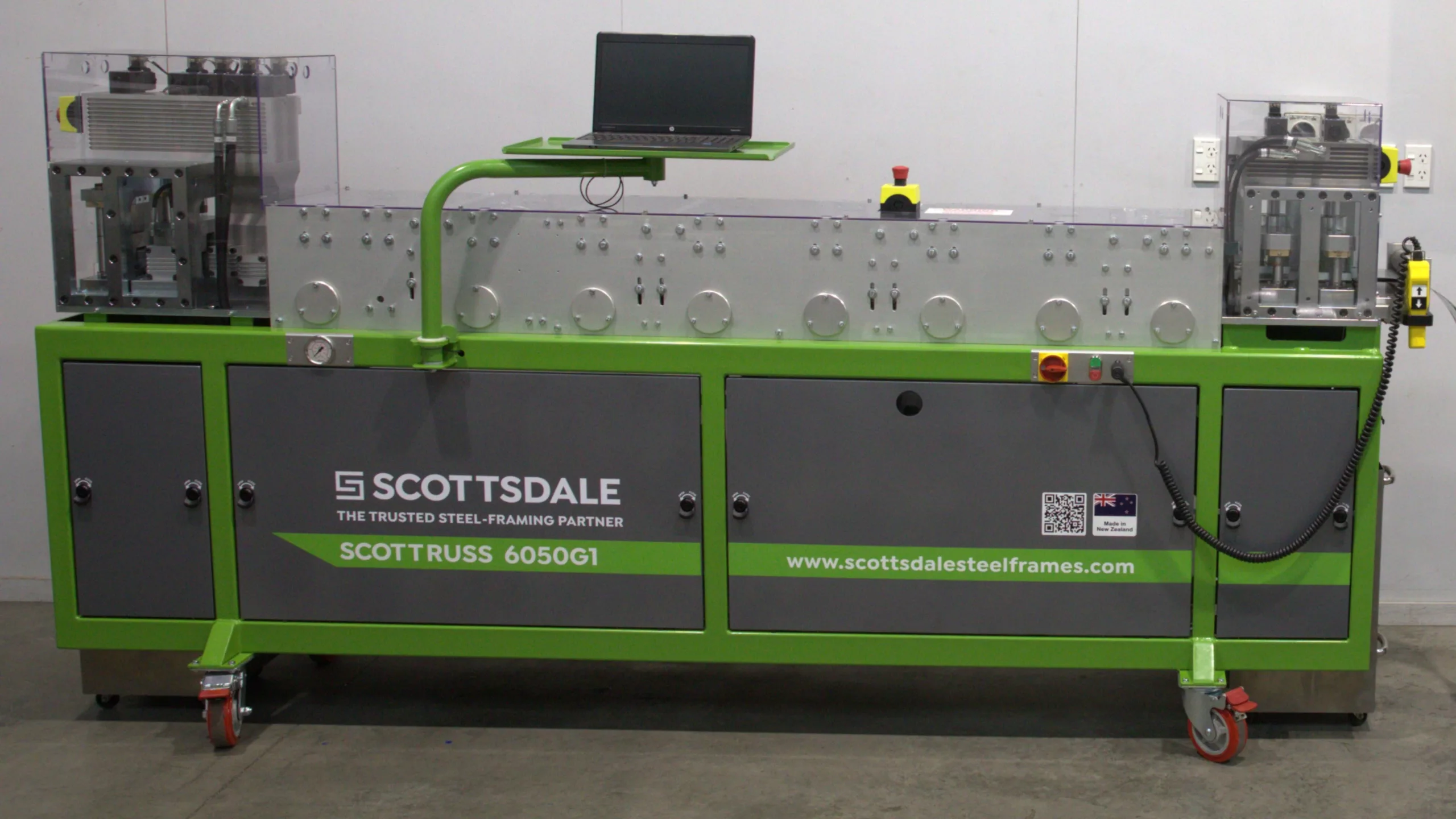
SCOTTRUSS
A high-capacity roll former for producing Hat section profiles, optimized for roof and floor trusses in residential and industrial buildings.
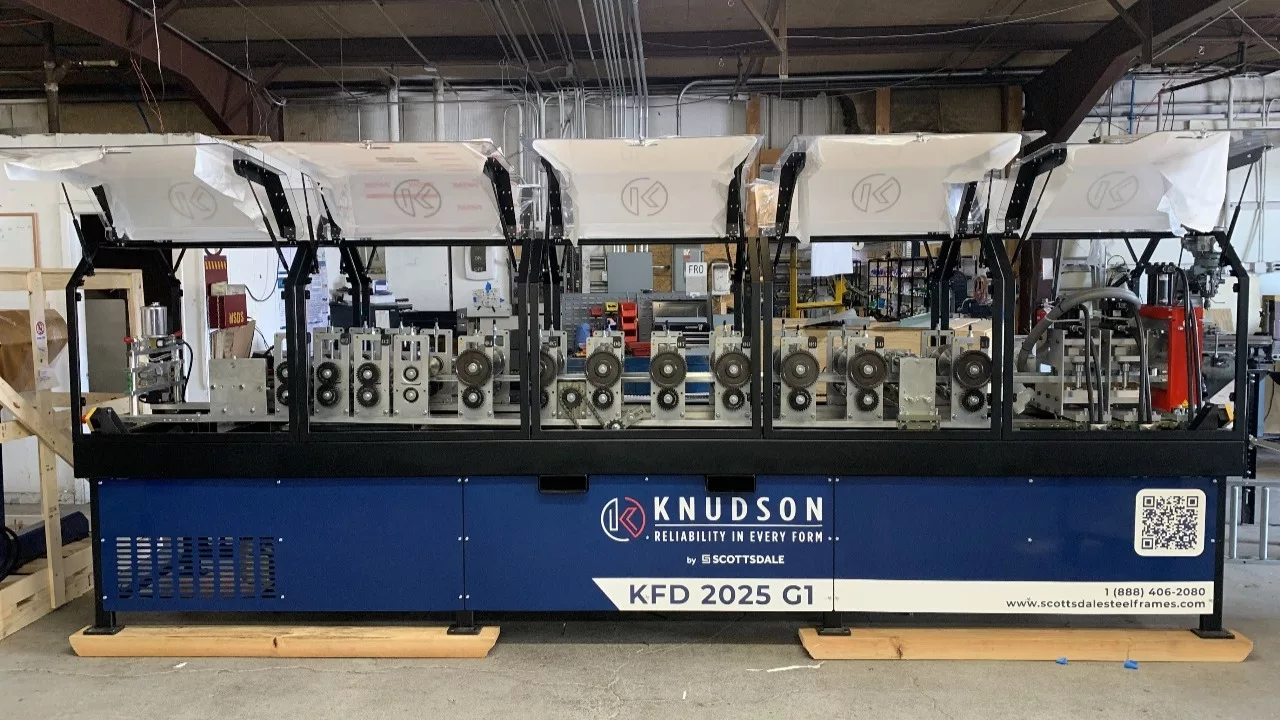
KFD Framemaker
A roll former specializing in producing light-gauge, non-structural framing elements like lipped and unlipped channel sections.
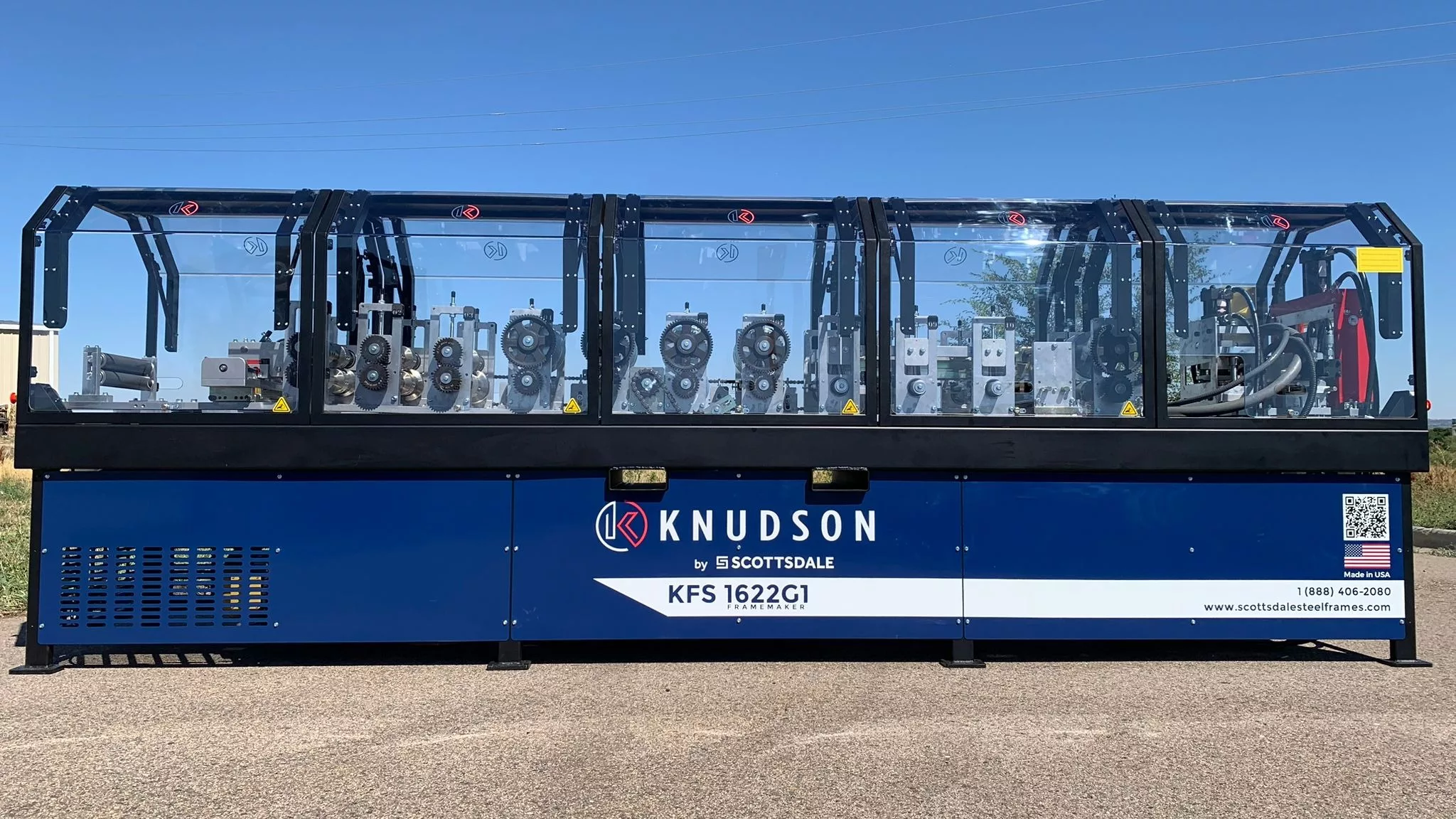
KFS Framemaker
A structural roll former capable of producing lipped and unlipped channel sections for high-strength framing applications.
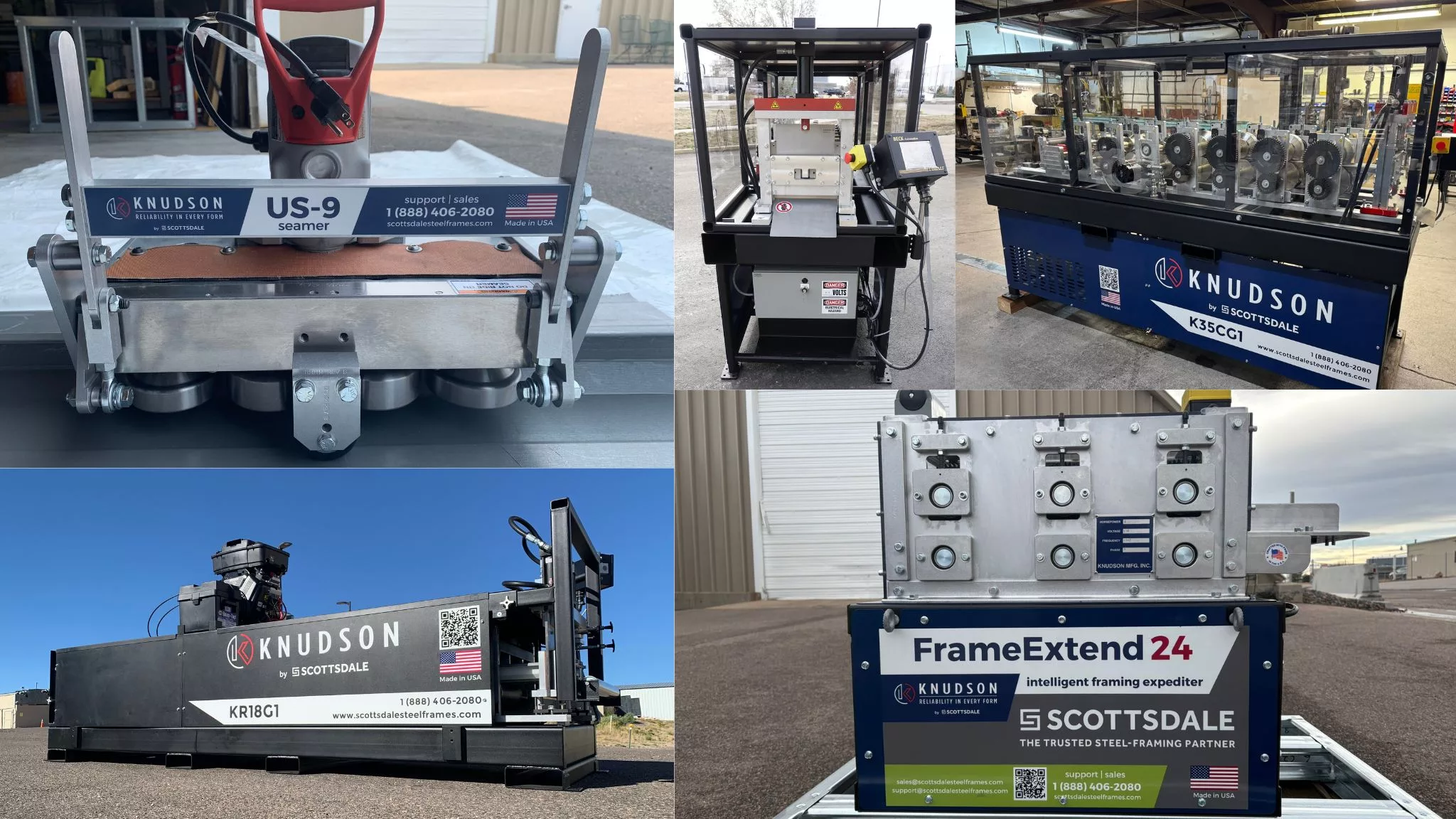
KSE
A versatile family of specialty roll forming machines and auxiliary equipment for roof sheathing and advanced applications in light-gauge steel framing.
At the core is the ScotPanel series, which produces C‑section profiles ideal for walls, roofs, ceilings, and support frames in residential, commercial, and modular construction applications.
Complementing it is the ScotTruss system, purpose-built to fabricate Hat‑section trusses for roof and floor systems, optimized for higher load and longer spans in both housing and industrial settings.
For advanced multi‑profile structural components, the KFS Framemaker delivers high throughput, up to 7,200 ft/hour, with hydraulic cutting, punching, and support for multiple flange and web configurations in heavy gauge steel.
Additionally, the KSE (Knudson SE) series offers standing‑seam roof panel forming with servo‑driven speeds up to 120 ft/min, custom hole punching, and compatibility with major software platforms like ScotRF and StrucSoft.
Together, Scottsdale’s ScotPanel, ScotTruss, KFS Framemaker, and KSE product lines showcase a full ecosystem of roll forming machines that support diverse design needs, production scales, and construction environments.
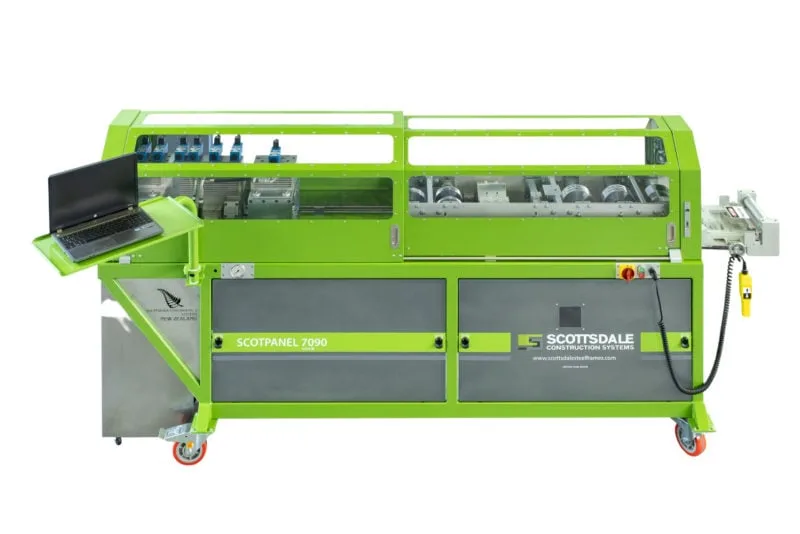
Conclusion
Incorporating a roll forming machine into a steel framing business offers a compelling mix of speed, cost-efficiency, quality, flexibility, and safety benefits. It enables faster project delivery with lower labor and material costs, while yielding precise, high-quality framing components. Builders gain control over their supply of studs and tracks, whether fabricating in a factory for maximum efficiency or on a job site for logistical convenience.
At Scottsdale Construction Systems, our technology offers a total enterprise solution and a complete ecosystem for anyone wishing to venture into the steel framing business or expand their current operations along any dimension of the construction supply chain.
Whether you’re transitioning from wood framing or starting fresh, our solutions are designed to make your journey seamless. We provide a centralized resource for all your steel framing needs, ensuring you have access to:
- Expert Guidance: Connect with industry veterans who bring decades of experience in cold-formed steel (CFS) framing. Their insights will help you navigate the complexities of the industry with confidence.
- Resource Network: Tap into a vast network of contractors, suppliers, and manufacturers. This network is your gateway to the best practices and materials available, streamlining your operations and enhancing your project’s success.
- Code Compliance Consultation: Stay ahead of regulations with our consultation services, ensuring your designs are not only innovative but also fully compliant with the latest codes.
Simply reach out to us, and we’ll align you with the right experts and resources tailored to your project’s unique requirements. Embrace the future of construction with tools and support that elevate your business to new heights.
Whether you’re planning a new construction project or considering renovation options, steel framing deserves serious consideration. Its structural integrity, design flexibility, and sustainability make it an excellent choice for various applications, from residential homes to commercial complexes.
Do you want to learn more about Scottsdale? We are happy to learn about your plans and tailor a solution customized specifically to your objectives. Contact us today to get started!
